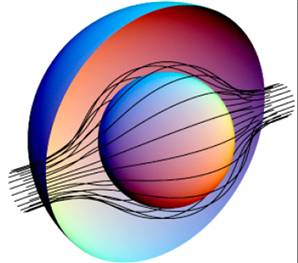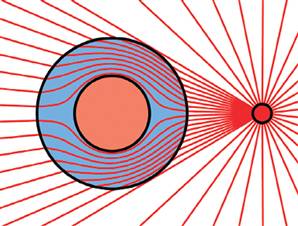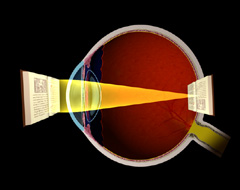
We see a thing by detecting light reflected from it. Three components are necessary to see something: 1. A light source. 2. A reflective object. 3. A receptive retina.
There are several obvious ways to make something invisible. Method one: turn off the lights. If no light is reflected from an object, you can’t see it. When it’s completely dark, all objects are invisible.
Method two: close your eyes. If the light reflected from objects does not reach your retinas, the objects are invisible.
Method three: put a box over the object. You would see the box, but you wouldn’t see the object because no light would be reflected from it. It would be invisible.

But now there is a new method four. Scientists at Duke University, the Imperial College London, and the SensorMetrix company in San Diego have created a device that reduces an object’s reflectivity and shadow. It diverts the light rays around the object so they do not reflect off it. If it reflects no light, you can’t see it. (Associated Press, 10/19/06)
(Diagrams from MSNBC)
(Actually, the device only works in 2 dimensions, not three, and it diverts microwaves, not visible light waves, but it is a demonstration of the feasibility of the concept).
How is this device different from putting a box over the object, which also prevents it from reflecting light? It differs in that you would not see the object or the box. You would just see the background behind the object as if it were not there.
In principle, you could touch the object and feel that it was there, but you couldn’t see it because no light would be reflected from it.
 Microwaves bent by the concentric walls of this 1-centimeter-thick invisibility device circumvent the center area and emerge on their original paths as if nothing had been in the way. The copper hoop that was cloaked in the tests isn't pictured. Picture from Science News, Oct. 21, 2006; Vol. 170, No. 17 , p. 261.
Microwaves bent by the concentric walls of this 1-centimeter-thick invisibility device circumvent the center area and emerge on their original paths as if nothing had been in the way. The copper hoop that was cloaked in the tests isn't pictured. Picture from Science News, Oct. 21, 2006; Vol. 170, No. 17 , p. 261.Now what if
I were the hidden object at the center of the device? I could be standing right in front of you and you wouldn’t be able to see me. But I couldn’t see you either! Any light reflected from you toward me would be diverted around me by the cloaking device and would never reach me. So I would see nothing.
I would be functionally blind. I could hold my hand in front of my face but I couldn’t see it because I need incident light to see things and there wouldn’t be any. For me, it would be like being in a totally pitch-black room. So invisibility makes you blind.

But what if I had a small flashlight with me? I could shine that on my hand, which would reflect the light and I could see my hand. I could read a book if I wanted. It would be like turning on the lights in my room.
If I shined my flashlight outward toward you, you would not see me, but only a strange bright spot in the background behind me.
If I shined the light onto myself, you would be able to see me, at least the parts of me illuminated by my flashlight. But I would seem to be a ghost, not properly connected to the background, because I would be illuminated by a different light source than the ambient incident light that was being diverted around me. Maybe it would look like stage lighting. And my eyes would appear as two black holes, because where they absorbed the light shining on me, none would be reflected back to you.
But I still couldn’t see you. I could only see the parts of my body illuminated by the light. No other reflected light would reach me. I would still be blind to the world.

So as far as the Harry Potter invisibility cloak goes, it wouldn’t be practical because its wearer would be functionally blind, although if his head stuck up out of the cloak, he could see while his body remained invisible, to himself and to others. That probably wouldn’t be very practical either. If you couldn’t see your own body, you probably would have trouble walking or moving about for any length of time. It would be like walking while looking up at the sky. You would soon bump into something or fall down, I think.
 The flat-bottom design would seem to give a fine reflecting surface to ground based radars, not stealthy at all. The ventral surface is no doubt coated with radar-absorbing material, but that couldn’t be adequate or else they would have made the plane aerodynamic and just coated it all. Seems to me this design would only deflect radar originating from angles above the aircraft. But most radars are below.
The flat-bottom design would seem to give a fine reflecting surface to ground based radars, not stealthy at all. The ventral surface is no doubt coated with radar-absorbing material, but that couldn’t be adequate or else they would have made the plane aerodynamic and just coated it all. Seems to me this design would only deflect radar originating from angles above the aircraft. But most radars are below. billion dollar aircraft.
billion dollar aircraft.









